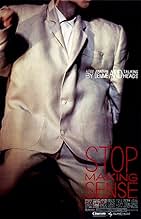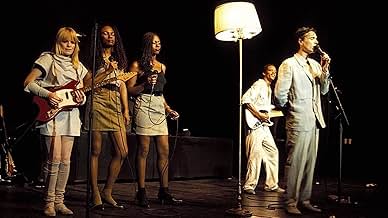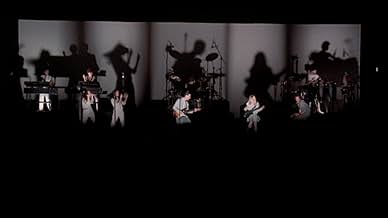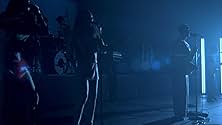AVALIAÇÃO DA IMDb
8,7/10
23 mil
SUA AVALIAÇÃO
Uma apresentação ao vivo da banda Talking Heads gravada ao longo de três noites no Pantages Theater de Hollywood em dezembro de 1983 e apresentando suas músicas mais memoráveis.Uma apresentação ao vivo da banda Talking Heads gravada ao longo de três noites no Pantages Theater de Hollywood em dezembro de 1983 e apresentando suas músicas mais memoráveis.Uma apresentação ao vivo da banda Talking Heads gravada ao longo de três noites no Pantages Theater de Hollywood em dezembro de 1983 e apresentando suas músicas mais memoráveis.
- Direção
- Roteiristas
- Artistas
- Prêmios
- 3 vitórias e 1 indicação no total
Steven Scales
- Self - Percussion
- (as Steve Scales)
Ednah Holt
- Self - Backing Vocals
- (as Edna Holt)
Talking Heads
- Themselves
- (não creditado)
- Direção
- Roteiristas
- Elenco e equipe completos
- Produção, bilheteria e muito mais no IMDbPro
Avaliações em destaque
It's a good thing that the Talking Heads broke up when they did. I mean, could you imagine them slogging it out today, playing the state fair circuit, or worse, the street fair circuit? No, watch this film. See a band at its creative and energetic peak. Remember them as they were over the two or three days in which it was filmed. Of course, you must watch David Byrne. He would make his entire body a performance art. He would contort, jog, dance, leap, and even make his clothes a prop.
But, watch Tina Weymouth...
Tina is a very visual performer too. She says almost nothing, letting her bass guitar speak for her. And while David goes over the top often, Tina is subtle and sublime. With her body moves as she dances in place. With her facial expressions, her smiles, occasional raised eyebrows, and glances. Then when the action shifts to the Tom Tom Club (in order to give David a break and allow him to change into his big suit), her big moment is for one song only--"Genius of Love" but man does she seize the moment and make it all her own! Rounding out the Talking Heads of course are drummer Chris Frantz (Tina Weymouth's husband for over 30 years now) and guitarist/keyboardist Jerry Harrison. When Chris takes the stage, he bounds up onto the riser, bows, and with a big smile, gets drumming. He is clearly enjoying himself during this and at the end of the show, he jubilantly throws his sticks into the audience. Jerry is a little harder to get a bead on. At times he's clearly enjoying himself, particularly on BURNING DOWN THE HOUSE. Other times he seems a little detached.
Rounding out the touring band are Alex Weir on lead guitar, Bernie Worrel on keyboards, Edna Holt and Lynn Marbry on back-up vocals, and Steve Scales on percussion. None are treated as sidemen, rather as an integral part of the show.
It has been commented that some "sweetening" of the sound was done. But I believe that it was to achieve sound consistency. I have heard several concert films with terrible audio (RUST NEVER SLEEPS comes to mind). Seeing this movie is what made me a Talking Heads fan back in 1985. Finding a copy at the used book store in 2006 is what helped me re-discover them.
It would be easy to dismiss the Talking Heads as all visual as all David Byrne. Such is not the case. The songwriting and musicianship was solid throughout the band's career. The band remained together for several more years, scoring several additional hits including AND SHE WAS, LADY DON'T MIND, & WILD WILD LIFE. They called it quits as a band in 1991, although all four members have remained active in music.
But, watch Tina Weymouth...
Tina is a very visual performer too. She says almost nothing, letting her bass guitar speak for her. And while David goes over the top often, Tina is subtle and sublime. With her body moves as she dances in place. With her facial expressions, her smiles, occasional raised eyebrows, and glances. Then when the action shifts to the Tom Tom Club (in order to give David a break and allow him to change into his big suit), her big moment is for one song only--"Genius of Love" but man does she seize the moment and make it all her own! Rounding out the Talking Heads of course are drummer Chris Frantz (Tina Weymouth's husband for over 30 years now) and guitarist/keyboardist Jerry Harrison. When Chris takes the stage, he bounds up onto the riser, bows, and with a big smile, gets drumming. He is clearly enjoying himself during this and at the end of the show, he jubilantly throws his sticks into the audience. Jerry is a little harder to get a bead on. At times he's clearly enjoying himself, particularly on BURNING DOWN THE HOUSE. Other times he seems a little detached.
Rounding out the touring band are Alex Weir on lead guitar, Bernie Worrel on keyboards, Edna Holt and Lynn Marbry on back-up vocals, and Steve Scales on percussion. None are treated as sidemen, rather as an integral part of the show.
It has been commented that some "sweetening" of the sound was done. But I believe that it was to achieve sound consistency. I have heard several concert films with terrible audio (RUST NEVER SLEEPS comes to mind). Seeing this movie is what made me a Talking Heads fan back in 1985. Finding a copy at the used book store in 2006 is what helped me re-discover them.
It would be easy to dismiss the Talking Heads as all visual as all David Byrne. Such is not the case. The songwriting and musicianship was solid throughout the band's career. The band remained together for several more years, scoring several additional hits including AND SHE WAS, LADY DON'T MIND, & WILD WILD LIFE. They called it quits as a band in 1991, although all four members have remained active in music.
Before I saw Stop Making Sense I had never been particularly concerned with The Talking Heads, or lead-singer and solo-artist David Byrne. Indeed, I had always been a fan of certain songs, such as "Burning Down the House" and "Psycho Killer", but I had never actually spent time becoming acquainted with the band's music on the whole. However, Stop Making Sense was something I was desperate to view, due to the substantial amount of praise that had been garnered over the years since its release. Now it is safe to say that The Talking Heads rank among my favourite bands, thanks to this masterpiece of musical art.
Essentially, Stop Making Sense is a showcase of the band's collected works. Throughout the 90-minute running-time the concert simultaneously covers the back-catalogue of The Talking Heads, through fluid, non-stop vibrancy. From "Found a Job" and "Take Me to the River" the work is merely a sample of the group's ability to provide some of the most engaging live shows ever recorded. To say that the film is "original" would be an understatement, given that the title still rings true today. Stop Making Sense defines the band's abilities, attitudes, styles and motifs. The New Wave approach the film takes is stylistically engaging to such an extent that it is virtually impossible to draw your eyes away from the screen. Minimalist set-pieces move along with the mood of the music at such a rate that much of the picture feels like a kaleidoscope of blistering sound and trancelike imagery.
David Byrne is the key constituent; bestowing his stage presence, creativity and musical proficiency. His stage dynamics are let loose during Stop Making Sense. The infamously over-sized business suit donned by David Byrne is otherworldly, just like the viewing experience, which transports you into a deep-seated, vivacious trance. Yet it is the suit which distinguishes the work completely. The fact that a regular item of clothing can have the ability to make the wearer seem out-of-proportion and disfigured is both mystifying and captivating. Even more bizarre is that the suit seems to grow relatively larger as the concert progresses. Personal interpretation could be that the suit is an implicative metaphor for the irony of the business world or conformity; on the other hand it could just be about not making sense.
Academy award winning director Jonathan Demme does not just "get the gist of The Talking Heads". Instead he is able to comprehend the themes of the band's work from an unmistakably refined tone that he captures through his direction. The irregularity of the group may be hard for some viewers to swallow, but that can be expected from a group which make music of an acquired taste. As for the choreography, it seems there is none, since the musicians all behave in a volatile and limitless manner. The progressively shifted set-pieces convey the altered reality that you have become apart of, and are an extraordinary example of unbound craftsmanship. Stop Making Sense ultimately displays the band's antics from their perspective; this is due to the extended takes of the performers and the lack of audience shots (the fans can only be seen during wide shots or when the camera moves behind the performers). There are even moments where the viewer effectively becomes apart of the band. A prime example of this manoeuvre is when the camera swings behind drummer Chris Frantz and faces the audience during the rendition of "Thank You for Sending me an Angel."
Characteristically speaking it is hopeless trying to describe the feeling you receive while viewing Stop Making Sense. This is because when seen and heard the mind becomes so fixated with the audacious madness of the piece that every viewer will react differently. Personally, this is the concert which I would irrefutably name as the finest ever recorded, maybe you will too.
Essentially, Stop Making Sense is a showcase of the band's collected works. Throughout the 90-minute running-time the concert simultaneously covers the back-catalogue of The Talking Heads, through fluid, non-stop vibrancy. From "Found a Job" and "Take Me to the River" the work is merely a sample of the group's ability to provide some of the most engaging live shows ever recorded. To say that the film is "original" would be an understatement, given that the title still rings true today. Stop Making Sense defines the band's abilities, attitudes, styles and motifs. The New Wave approach the film takes is stylistically engaging to such an extent that it is virtually impossible to draw your eyes away from the screen. Minimalist set-pieces move along with the mood of the music at such a rate that much of the picture feels like a kaleidoscope of blistering sound and trancelike imagery.
David Byrne is the key constituent; bestowing his stage presence, creativity and musical proficiency. His stage dynamics are let loose during Stop Making Sense. The infamously over-sized business suit donned by David Byrne is otherworldly, just like the viewing experience, which transports you into a deep-seated, vivacious trance. Yet it is the suit which distinguishes the work completely. The fact that a regular item of clothing can have the ability to make the wearer seem out-of-proportion and disfigured is both mystifying and captivating. Even more bizarre is that the suit seems to grow relatively larger as the concert progresses. Personal interpretation could be that the suit is an implicative metaphor for the irony of the business world or conformity; on the other hand it could just be about not making sense.
Academy award winning director Jonathan Demme does not just "get the gist of The Talking Heads". Instead he is able to comprehend the themes of the band's work from an unmistakably refined tone that he captures through his direction. The irregularity of the group may be hard for some viewers to swallow, but that can be expected from a group which make music of an acquired taste. As for the choreography, it seems there is none, since the musicians all behave in a volatile and limitless manner. The progressively shifted set-pieces convey the altered reality that you have become apart of, and are an extraordinary example of unbound craftsmanship. Stop Making Sense ultimately displays the band's antics from their perspective; this is due to the extended takes of the performers and the lack of audience shots (the fans can only be seen during wide shots or when the camera moves behind the performers). There are even moments where the viewer effectively becomes apart of the band. A prime example of this manoeuvre is when the camera swings behind drummer Chris Frantz and faces the audience during the rendition of "Thank You for Sending me an Angel."
Characteristically speaking it is hopeless trying to describe the feeling you receive while viewing Stop Making Sense. This is because when seen and heard the mind becomes so fixated with the audacious madness of the piece that every viewer will react differently. Personally, this is the concert which I would irrefutably name as the finest ever recorded, maybe you will too.
Stop Making Sense is the kind of concert film that gets you pumped up for the Talking Heads even if you're not that huge a fan. I love a few of their songs- Take Me to the River, Burning Down the House, Psycho Killer most of all- but I never really "got in" to them at a younger age, mostly because I knew them from classic rock radio. What Jonathan Demme as director presents with his film of their concert in 1984 is to energize fans and casual listeners to their presence and power and just plain f***ing fun. The main force behind the group, singer/guitarist David Byrne wears suits 10 times too big, runs laps around the stage (while also having back-up singers jogging in place as well), and creates crazy pop-culture and avant-garde imagery on behind them on a screen. It's madness, but it's also alive in performance and song all the way.
Maybe one or two songs might not totally click or may sound a little, well, dated (it was the 80s after all, no longer the folks from CBGB's), but there's constantly memorable moments, including the opening take on Psycho Killer, the building-block form from song to song as band members join one by one until it's a good dozen players and singers all in the mix, and with the imagery that Demme and DP Jordan Crenowith create. For the most part it's (perfectly) straightforward film-making... but here and there we see real artistry break through, shadows cascading the figures playing, the juxtaposition of Byrne in that suit flopping around, moving around seamlessly between musicians. It's the kind of craftsmanship that looks like it should be easy enough with a good few cameras, yet probably took as much prep work as Scorsese had on the Last Waltz.
So, take in all of the 80's New-Wave mood (and, make no mistake, it's VERY 80's New Wave, but probably in the best and most experimental sense imaginable), take in pretty much all of the classic Talking Heads numbers (there's one I forget the name of that's especially chilling with the chorus a series of 'ya-hay-hay-hay-hay-hay's' from Byrne in marching formation). It's probably one of the best modern concert films.
Maybe one or two songs might not totally click or may sound a little, well, dated (it was the 80s after all, no longer the folks from CBGB's), but there's constantly memorable moments, including the opening take on Psycho Killer, the building-block form from song to song as band members join one by one until it's a good dozen players and singers all in the mix, and with the imagery that Demme and DP Jordan Crenowith create. For the most part it's (perfectly) straightforward film-making... but here and there we see real artistry break through, shadows cascading the figures playing, the juxtaposition of Byrne in that suit flopping around, moving around seamlessly between musicians. It's the kind of craftsmanship that looks like it should be easy enough with a good few cameras, yet probably took as much prep work as Scorsese had on the Last Waltz.
So, take in all of the 80's New-Wave mood (and, make no mistake, it's VERY 80's New Wave, but probably in the best and most experimental sense imaginable), take in pretty much all of the classic Talking Heads numbers (there's one I forget the name of that's especially chilling with the chorus a series of 'ya-hay-hay-hay-hay-hay's' from Byrne in marching formation). It's probably one of the best modern concert films.
I bought this film without ever having seen it. I liked the Talking Heads and had heard about the movie. Suffice it to say that I was amazed! The genious of starting with just a bare stage with David Byrne singing his sublime live version of Psycho Killer, then adding equiptment and band members was so weird, so brilliant. The energy and stamina shown by Mr. Byrne in this film borders on creepy. Was there a mountain of coke backstage, or is he a marathon runner? Not for me to know. How he was able to bend that far backwards during Once In A Lifetime I'll never know! All in all a real concert experience, combining the brilliance and showmanship of the Talking Heads with a master director like Jonathan Demme. It's no wonder that their compilation, Sand In The Vaseline, includes two live tracks seen on the film.
10nolesce
I saw this movie when it was released. In our town (Sarasota, Florida then) it was a midnight movie in the theater next to 'The Rocky Horror Picture Show'. I played in a band at the time and was a fan of the Talking Heads so I was stoked to see the film. A band-mate and I went opening night and were blown away. People were dancing in the aisles by about the third song. We went back the next night and several nights there after with our girlfriends and others and had a blast. Our friends weren't particularly fans of the talking heads but they loved the movie. Most of us though the first time through just watched in awe. and when you left after just watching it and absorbing it you were speechless (ar at best unintelligible) for about 20 minutes after. It truly was that kind of film. As said elsewhere after seeing it you wonder why no other concert films have even attempted to emulate "Stop Making Sense". I suppose they figured they would just look lame or they just didn't get it.(or maybe some of both). If you don't want to buy it at least rent it (then you WILL want to buy it). This is the concert film all the others want to be when they grow up.
Você sabia?
- CuriosidadesThe footage was culled from several different shows. In order to minimize the amount of cameras in the frame, one show was shot completely from one side of the stage, and the next night was shot from the other side.
- Erros de gravaçãoThe concert was edited together from three shows and, it being a "live" show, things not planned happened. The first night, David Byrne put on the baseball cap that was thrown on stage from the audience; the next night, it can be seen next to the drums so that he can put it on again.
- Citações
David Byrne: Thanks! Does anybody have any questions?
- Versões alternativasVideo release is 12 minutes longer and features three additional songs not included in original theatrical version.
- ConexõesEdited into Talking Heads: Girlfriend Is Better (1984)
Principais escolhas
Faça login para avaliar e ver a lista de recomendações personalizadas
- How long is Stop Making Sense?Fornecido pela Alexa
Detalhes
- Data de lançamento
- País de origem
- Central de atendimento oficial
- Idiomas
- Também conhecido como
- Talking Heads: Stop Making Sense
- Locações de filme
- Empresas de produção
- Consulte mais créditos da empresa na IMDbPro
Bilheteria
- Orçamento
- US$ 1.200.000 (estimativa)
- Faturamento bruto nos EUA e Canadá
- US$ 10.306.902
- Fim de semana de estreia nos EUA e Canadá
- US$ 41.666
- 21 de out. de 1984
- Faturamento bruto mundial
- US$ 13.137.104
- Tempo de duração1 hora 28 minutos
- Cor
- Mixagem de som
- Dolby Stereo(original release)
- Dolby Atmos
- Proporção
- 1.37 : 1(original ratio)
Contribua para esta página
Sugerir uma alteração ou adicionar conteúdo ausente




























